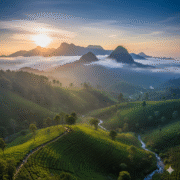
The Northern Monastery of Anuradhapura: Abhayagiri Vihara
- November 13, 2025
- eunoialankatours
- 7:07 pm
Anuradhapura, Sri Lanka’s first great capital, is more than a city of ruins – it is a living chronicle of devotion, resilience, and artistry. Among its many treasures stands the Northern Monastery, better known as Abhayagiri Vihara, a colossal monastic complex that once rivalled the greatest centres of Buddhism in Asia. Covering nearly 200 hectares, this UNESCO World Heritage Site is a window into a civilisation where faith, learning, and art flourished for over a millennium.
Origins Rooted in Resilience
The story of Abhayagiri starts with King Vattagamani Abhaya (Valagamba), who lost his throne in 103 BCE to South Indian invaders. As he fled Anuradhapura, a Jain monk mocked him, shouting, “The great black Sinhala is running away!”
The king was embarrassed but determined. After 14 years in exile, Valagamba returned, defeated the invaders, and retook his throne in 89 BCE. He kept his promise and started Abhayagiri Vihara right on the spot of the insult. Abhayagiri became more than just a monastery; it was a symbol of the country’s revival and the Buddhist faith’s victory.
A Golden Age of Buddhism
By the 3rd century CE, Abhayagiri had become one of the best Buddhist universities in the world, alongside Nalanda in India.
- Diversity: Monks here learnt about Theravāda, Mahāyāna, and Vajrayāna, making it a place where many different ideas and beliefs could be found.
- The Sacred Relic: When the Sacred Tooth Relic of the Buddha arrived in Sri Lanka in the 4th century, it was first put on display at Abhayagiri.
- Global Reach: The Chinese monk Fa-Hsien wrote about 5,000 monks living here in the 5th century. Sri Lankan nuns from Abhayagiri even helped start the bhikkhuni order in China, and its influence spread to Java and Southeast Asia.
Architecture and Innovation: An Ancient Smart City
The Abhayagiri complex was an amazing example of ancient planning, featuring roads, stupas, image shrines, and residences.
| Architectural Marvel | Detail & Significance |
|---|---|
| Abhayagiri Stupa | Once over 100m high, it was among the tallest brick monuments in the ancient world. It still dominates the plain at 75m today. |
| Twin Ponds (Kuttam Pokuna) | Masterpieces of hydrological engineering, noted for their symmetrical stone steps and artistic carvings of fish and lotuses. |
| Elephant Pond (Eth Pokuna) | The size of six Olympic pools, it supplied water to thousands of resident monks through underground channels. |
| Monk Residences | Featured two-storey buildings with libraries, drainage systems, bathing ponds, and even flushable toilets connected to septic tanks. |
| The Great Refectory | Featured a stone trough described as “the world’s largest rice bowl,” capable of holding meals for thousands of monks at once. |
- Artistic Highlights: The Samadhi Buddha Statue, serene in meditation, reflects Gupta-inspired artistry. Guardstones and Moonstones, unique to Sri Lankan architecture, showcase intricate carvings of nagas (serpent kings) and lotuses.
Decline and Rediscovery
Abhayagiri, like all of Anuradhapura, was invaded by South Indians many times between the 9th and 11th centuries. The monastery slowly fell out of use after the capital moved to Polonnaruwa. By the colonial era, it was buried under jungle growth.
Thanks to the efforts of scholars like H.C.P. Bell and Senarath Paranavitana, and later the Cultural Triangle Project, the beauty of Abhayagiri has been rediscovered. Visitors can now walk through its streets and marvel at a monastery that was once the centre of Sri Lankan Buddhism.
Why Visit Abhayagiri Today?
For travellers, Abhayagiri is not just ruins – it is an immersive journey into the spiritual and cultural soul of Sri Lanka. Here you will:
- Stand before one of the largest brick stupas in the world, feeling the weight of centuries.
- Gaze at the Samadhi Buddha, a statue so peaceful it inspired leaders like Jawaharlal Nehru during his imprisonment.
- Walk through the Twin Ponds, imagining monks bathing in their cool, filtered waters.
- Explore moonstones, guardstones, and sculptures that reveal how Buddhism absorbed and reshaped South Asian art.
Abhayagiri Vihara is a reminder of Sri Lanka’s role as a crossroads of civilisation, where art, religion, and engineering reached astonishing heights.
Practical Information for Visitors
- Location: Northern sector of Anuradhapura Sacred City (UNESCO World Heritage Site).
- Best Time to Visit: Morning or evening, when the light softens on the ruins.
- Travel Tip: Combine your visit with nearby sites such as the Jetavana Monastery, Ruwanweliseya Stupa, and Samadhi Buddha Statue for a complete Anuradhapura experience.
With Eunoia Lanka Tours, step into the timeless ruins of Abhayagiri, where kings, monks, and pilgrims once walked. Discover the grandeur of Sri Lanka’s ancient monasteries and feel like a local in a land where every stone whispers a story.


